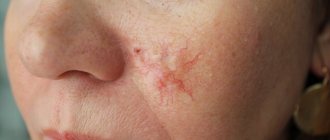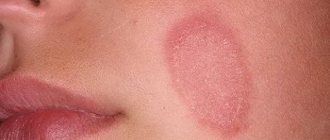Keratoma is a benign formation on the skin that appears due to a local accumulation of horny cells of the epidermis. Outwardly, such manifestations resemble convex pigment spots with hard scales on the surface. And they are often located on the face, forearms, upper back, and arms.
Single or multiple keratomas are typical for mature people over 40 years of age. This skin pathology is rarely encountered in children and young people. They appear equally in men and women. Cases of self-healing have been recorded when formations of this type disappeared by themselves. But often raised dark spots reappear in the same areas of the skin.
Are keratomas dangerous? Do they need to be treated or not? How to get rid of keratomas at home? The specialists of the Medical Center for the Diagnostics of Moles “Lazersvit” have the answers to all these questions.
Keratomas: causes of appearance?
Keratoma, according to dermatologists, develops for one of two reasons - excessive ultraviolet radiation and the physiological processes of aging of the skin. The predisposition to the development of pathology, according to medical experts and geneticists, is inherited. But there are no clear reasons for the appearance of a formation, such as, for example, in condyloma, which is caused by the human papillomavirus. At one point, an accumulation of cells is observed, which leads to an anomaly.
Skin keratoma, as a rule, does not pose a threat to health. But dermatologists strongly recommend observing the spots. After all, individual formations have a tendency to reproduce and grow. And in rare cases, they degenerate into malignant neoplasms.
Causes of keratoma formation
Keratomas have a multifactorial etiology. First of all, age-related degeneration of skin cells is important. In addition, the following factors are important:
- Excess ultraviolet radiation.
- Age-related decrease in immune defense. As a consequence, intensive growth of epidermal cells and the formation of areas of hyperkeratinization and keratinization occur.
- Neuroendocrine pathology.
- Vitamin A deficiency.
- Endocrine disorders and sexual involution (menopause).
- Long-term use of certain medications.
- Skin exposure to chemicals.
Why should a keratoma be observed?
The skin disease keratoma is considered by oncologists to be a borderline formation, especially in patients with an increased risk of cancer. The probability of malignancy into melanoma or basal cell carcinoma varies in different age groups in the range of 8-35%. For this reason, people who have one or more formations of this type are recommended to see a dermatologist. Regular visits to the doctor allow you to notice signs of degeneration in the early stages and begin treatment in a timely manner. Well, it’s better to remove the protruding spot in order to prevent even the minimal likelihood of pathological processes.
The risk of cancer is not the only reason to see a doctor. Keratoma on the face is perceived as a cosmetic defect, attracts the attention of others, and becomes the cause of complexes. A convex formation on the body can be injured by tight clothing or accessories. In this case, there is a threat of secondary infection.
Age-related keratoma “loves” to grow on the scalp. The formation is often damaged by a comb and hairdresser's accessories during cutting and styling.
Each case of keratoma requires an individual approach. And only a qualified doctor can give recommendations to the patient - treat or remove, ignore or observe.
Rehabilitation period after keratoma removal
Removal of keratomas by any of the above methods involves a postoperative period, which lasts differently. The longest recovery process is observed after surgery. It can range from 2 weeks to 4 months.
After removing a keratoma using any of the destructive methods, it is important to adhere to the following recommendations:
- avoid contact of water and moisture on the affected area of the skin;
- do not remove the crust on the treated area of the dermis, as this can lead to the appearance of scars, scars and infection;
- try not to touch the inflamed epithelium and not expose it to ultraviolet radiation;
- use medications prescribed by a doctor;
- do not self-medicate, do not resort to traditional medicine unless your doctor approves it.
If you follow these recommendations, the regeneration process will be quick, painless and without complications.
After the keratoma removal procedure, it is important to come to an in-person appointment with a doctor for an examination 10–12 days later. The doctor will be able to evaluate the effectiveness of the applied technique and outline a plan for further action, as well as give recommendations for skin care.
In our clinic, you can remove keratomas using liquid nitrogen, as well as any other methods at an affordable price. After consultation, specialists will select the most suitable procedure and eliminate the skin defect.
Why clients choose Veronika Herba Beauty and Health Center:
- This is a beauty center where you can take care of yourself at a reasonable cost, while your face and/or body will be treated not by an ordinary cosmetologist, but by one of the best cosmetologists in Moscow. This is a completely different, higher level of service!
- You can receive qualified help at any time convenient for you. The beauty center is open from 9:00 to 21:00, seven days a week. The main thing is to agree with your doctor in advance on the date and time of your appointment.
Sign up for a consultation with a specialist by phone +7 (495) 085-15-13
, and you will see for yourself!
Classification
Keratomas are classified as follows:
- Seborrheic keratoma appears most often on the chest, back and scalp. Initially, this is a yellow-brown spot, the diameter of which can reach 3 cm. Over time, the surface of the formation becomes dense, and scales appear on it. The color changes to dark brown or black. Externally, this skin pathology looks like dried raisins stuck in the skin.
- Senile keratoma affects the skin of people over 35 years of age. A spot with a diameter of up to 2.5 centimeters appears on the skin. Over time, it thickens, becomes crusty, cracks, and changes color from yellow to black. The growth grows slowly, but over time it can protrude above the skin by a centimeter or even more. Senile keratoma, as this type of neoplasm is also called, is often localized on the shoulders, head, and back. Less common on the face and neck. Senile keratomas can grow in colonies. They also often become inflamed due to physical damage.
- Horny keratoma, which dermatologists often call “cutaneous horn,” has an increased risk of degeneration. First, a gray or brown spot appears on the skin, which eventually becomes covered with scales. A convex tubercle with a rough surface is suitable for placement of the arms, chest, and back. But other parts of the body are no exception. Sometimes patients are diagnosed with multiple horny keratomas.
- Follicular keratoma appears on the cheeks, lips, nose, eyelids. The skin first turns pink, then small tubercles grow at the site where the spot appears.
- Angiokeratoma is a nodular formation of red, black or blue color. Its size can reach 10 centimeters, but most often the growth grows to 2-3 centimeters. Often such skin pathologies form on the back, abdomen, legs and genitals.
- At the first stage, solar keratoma looks like a flat mole. Gradually it begins to peel off. Scales form on its surface. Dense lesions are often found in men over 40 years of age. Location: back, face, feet. Education is rarely singular. As a rule, this is a whole colony of growths. In some cases, degeneration into squamous cell carcinoma is diagnosed.
The type of keratoma and its risks for the patient are diagnosed by a dermatologist after examining the formation.
Make an appointment with a dermatologist
Timely treatment
The best way to fight cancer, one of the most terrible diseases facing humanity, is prevention. As soon as a keratoma appears, it is advisable to immediately, without delay, consult a dermatologist for laser removal. The smaller and more insignificant the skin tumor, the greater the likelihood that after its removal there will be no trace left on the body. Well, of course, such a step will significantly reduce the risk of malignant degeneration.
At the moment, only one way to treat keratoma is known - it must be removed.
This is a radical method, which can only be carried out efficiently by a qualified specialist. If suspicious growths are detected on the skin, you should contact specialized clinics and centers such as SkinLazerMed. The best option is to consult a dermatologist or dermato-oncologist.
Attempts to get rid of keratomas on your own can be fraught with the formation of unsightly scars at best, and the development of skin cancer at worst.
Diagnostics
An appointment with a dermatologist begins with taking an anamnesis. The doctor clarifies how long ago the formation was, asks the patient about sensations - painful manifestations, itching, and studies the symptoms. Next, the skin is examined to determine the size and location of the keratoma. The instrumental method - dermatoscopy - allows you to clarify the diagnosis and exclude other skin diseases.
A special device allows you to identify the formation, examine the structure of its tissues, and the depth of its occurrence. The dermatoscope magnifies the image many times, so errors are excluded. And if there is a risk of the keratoma degenerating into a tumor, the doctor will determine this. In some cases, histology is recommended - the formation is sent to the laboratory to determine the cellular composition.
Destructive methods for removing keratomas
Compared to removing keratoma with ointments, surgical excision is the fastest and most effective way to eliminate cosmetic skin imperfections. Modern medicine offers several destructive types of treatment for dermatological formations. Methods for removing keratomas are:
- treatment of growths with radio waves;
- removal of keratoma with liquid nitrogen;
- cauterization of tumors with electric current (electrocoagulation);
- laser burning of epithelial defects;
- surgical removal of growths.
The doctor at the clinic helps the patient choose the most effective and appropriate of the listed methods for removing skin defects.
- Radio wave removal of large keratomas
One of the most gentle ways to influence the skin is radio wave removal of keratoma. To perform the operation, a special device is required - surgitron. Narrowly directed radio waves emitted by this device affect different layers of the skin, causing evaporation of intracellular fluid and destruction of the keratoma. Using an applicator, the doctor controls the depth of treatment of the epidermis during the procedure, which helps fight formations of different sizes. To eliminate pain during the session, local anesthesia is used.
Advantages of keratosis removal using the radio wave method:
- minimal impact on healthy skin;
- speed and high efficiency of the procedure;
- absence of complications and scars after manipulations;
- short recovery time for the epidermis;
- possibility of treating large areas of keratoma localization.
- Laser removal of keratomas
Laser correction of skin tumors is an effective method for treating diseases of the dermis, the essence of which is the effect of laser beams on altered epithelial cells and their destruction. Since the laser prevents the opening of bleeding, the risk of complications is minimal. This technology involves exposing the skin to high temperature, which blocks the development of bacteria and infection. Healthy skin is not subject to the destructive effects of the laser, so there are no scars left after the procedure. Laser keratosis removal is suitable for patients who have increased sensitivity to light or dark, tanned skin.
- Removal of keratomas with liquid nitrogen
Cryotherapy, or exposing the skin to liquid nitrogen, is another effective way to remove tumors. Using a special apparatus or a cotton pad, liquid nitrogen is applied to problem areas, which leads to instant freezing of pathologically altered epithelial cells. This technique provides high aesthetic results, since under the influence of cold, keratoma cells fall off, and healthy skin is not injured.
However, there is a possibility of relapse of the disease, since the root of the tumor is not completely removed. If the keratomas are small and there are not many of them, removal can be done in one session. Foci of accumulation of neoplasms should be treated with nitrogen over several visits to the dermatologist. At your appointment, a qualified doctor will be able to assess the extent of skin damage and prescribe the required number of procedures.
We recommend
Laser aesthetic cosmetology: the perfect technique for an ideal appearance Read more
Cryotherapy has a significant drawback. After a session to remove keratoma with liquid nitrogen, a bubble forms on the skin, which does not go away for several days. It is important not to damage this area during hygiene procedures, as this may disrupt the healing process. Puncture of the bladder may contribute to the development of wound infection. If the resulting bubble causes significant inconvenience to the patient, it is necessary to consult a doctor who will treat the wound and apply a sterile bandage.
The nitrogen therapy procedure is contraindicated for people prone to allergic reactions to exposure to low temperatures, with chronic and oncological diseases in the acute stage, and who are carriers of the herpes virus. Infectious and inflammatory processes are also a limitation.
- Electrocoagulation of keratome
Removal of keratomas using electrocoagulation is another modern and effective way to get rid of tumors on the skin. It is especially effective when dealing with fresh growths. If keratomas have appeared a long time ago, coagulation is unlikely to help. The essence of this method is the destructive effect of electric current on keratoma cells, which leads to necrosis of pathological tissues and their loss. This procedure is quite painful, so it is performed using local anesthesia. Electrocoagulation involves removing tumors without affecting healthy epithelial cells. This is especially important if there is a risk of degeneration of a benign tumor into a malignant one.
- Surgical excision of keratoma
The surgical method of excision of keratoma involves performing the procedure using a scalpel. The doctor may prescribe surgery under local anesthesia in the following cases:
- the presence of contraindications for other destructive methods of keratoma removal;
- the process of degeneration of keratoma into a malignant formation;
- large areas of skin damage;
- ineffectiveness of other methods of treating skin diseases.
The surgical method of removing keratoma has a number of disadvantages:
- long and painful postoperative recovery period;
- damage to healthy dermal tissue around the site of keratoma localization;
- risk of wound infection and bleeding;
- the need for suture material;
- scars and scars after surgery.
To speed up the process of tissue regeneration and reduce the risk of infections, the doctor prescribes antibiotics and painkillers to the patient.
Keratoma: how to treat?
To help the patient get rid of keratoma or actinic keratosis, the doctor prescribes a conservative or surgical treatment method. If drug therapy does not produce results, if the location of the formation is unsuccessful, if it is perceived as a cosmetic defect, surgery to remove the keratoma is prescribed.
Drug therapy
Drug treatment involves the use of various ointments, solutions or emulsions with active substances. It is immediately important to note that such methods are effective in the initial stages, when the stain has just appeared. Therapy must be prescribed by a doctor. Self-medication is strictly not recommended, as it can cause complications in the form of damage to surrounding healthy tissue.
Keratoma: how to remove surgically?
The keratoma is surgically removed using one of the following methods:
- laser method;
- cryodestruction;
- radiosurgery method.
The leader of choice is laser removal, since it minimizes the risks of negative consequences, bleeding, wound infection, and relapses. In a few minutes the formation is completely removed. And the wound heals within a few days.
Possible risks
Attempts to remove the keratoma yourself by tying it with thread or cauterizing it with aggressive media are strictly prohibited. This can lead to serious consequences, including the degeneration of a benign tumor into cancer.
Removal of keratoma: main methods and their features
Keratoma removal is a surgical operation, a destructive method of treating skin diseases, which involves excision of excess epithelial formations. Keratoma is a special formation of the epidermis that is dark brown or yellowish in color, resembling a pigment spot. The size of a keratoma can range from small (a few millimeters) to large (several centimeters). Usually this is a single spot, but sometimes they can form small groups. Keratomas are not dangerous to health and usually do not cause significant discomfort to a person. They can go away on their own when the keratinized cells completely exfoliate and fall off.
Doctors say that keratoma is not hereditary, but is the result of the influence of negative environmental factors. The main one is exposure to ultraviolet radiation during uncontrolled exposure to the sun, due to which skin cells die and become keratinized, forming keratomas. Over time, they grow and change color to dark or yellow.
Keratoma is not at all life-threatening and is not a cause for concern. However, it can cause significant physical and aesthetic discomfort to a person. In addition, there is a possibility that when exposed to certain negative factors, it will degenerate into a malignant tumor.
The procedure for removing keratoma has multiple positive reviews. This is the best way to get rid of complexes and prevent the development of serious health problems. It is not recommended to remove keratoma at home. An operation to get rid of a skin tumor must be carried out in a medical clinic only by certified specialists in a way that is most suitable for the patient due to the individual characteristics of his body.
Removal using radio waves
Radioknife, or radio wave surgery (Surgitron device) is the most universal method for removing dermatological tumors, which can be used even in hard-to-reach locations. As in the previous case, the method is based on heating and evaporation of cells under the influence of radio frequency waves. The technology allows for targeted effects down to several millimeters. The surrounding tissues are not affected. Another advantage of the method is a good cosmetic result - healing occurs practically without the formation of noticeable marks and scars.
Clinical picture of the disease. Reasons for the development of pathology
Pathology is a benign neoplasm that forms on the skin. Excessive growth of cells of the epidermis, the surface layer, leads to the formation of compactions and growths, with a clearly defined pigment effect. Seborrheic keratosis
age-related disease. The older a person gets, the greater the likelihood of developing such tumors on the skin. Pathology manifests itself in the form of a single focus or in the form of clusters. In terms of size, keratosis can have different dynamics. Occurring in different parts of the body, neoplasms can range in size from one or two millimeters to larger ones, 3-5 cm in diameter. A special feature of keratosis is its visual resemblance to fragments of dirt adhering to the human body.
In almost every case, the pathology develops in several places, occupying larger areas of the skin with age. Almost every second patient over 60 years of age has similar neoplasms on the body, colloquially called senile shells. In medical practice, there are cases when seborrheic keratosis
appears on the body of women during pregnancy. On the body of patients of both sexes, pathology can occur during a course of hormonal therapy or as a result of the development of systemic diseases. The localization of keratosis is usually the back, cervical region, and areas of skin on the forearm. Less commonly, pathology develops in other parts of the body in the form of multiple clusters.
The true reasons for the development of pathologies have not been fully studied. One of the versions current in medical circles is that a hereditary factor is considered the cause of the pathology. In most cases, based on the data obtained, seborrheic keratosis
considered a familial disease.
The impact of active solar radiation on the formation of keratoma is not significant. The main factor that causes the development of pathology is the age of a person and the patient’s genetic predisposition to the formation of changes in the skin.
In the process of studying pathology, the similarity of seborrheic keratosis with manifestations of other diseases was established. To exclude suspicion of a malignant tumor, when pathology appears, consultation with specialist doctors, including a dermatologist and oncologist, is necessary. Determining whether a pathology belongs to a certain type is possible with a thorough medical examination, taking into account external signs.
Diagnosis of seborrheic keratosis
is not a signal for immediate removal of the tumor. The final choice in favor of treating the pathology lies with the patient. Doctors recommend treating pathology in the following cases:
- the likelihood of mechanical damage to the neoplasm during life;
- inflammation of a neoplasm associated with unpleasant physical sensations and bleeding pathology;
- rapid increase in the size of the pathology;
- the pathology represents a serious cosmetic defect for the patient.
Most patients who resort to treatment for keratosis are women, regardless of age, for whom the aesthetic perception of their own appearance remains important. For men, treatment of keratosis is determined more by the risk of mechanical damage to the pathology as a result of life activities.
Traditional medicine in the treatment of keratoma
Traditional medicine recipes can be used as additional therapy and only after consultation with a doctor!
Celandine ointment and a mixture of fir and sea buckthorn oil will help slow down the growth of the tumor. You need to lubricate the keratoma three times a day for two weeks. In parallel with the main treatment, you need to adjust your diet - doctors recommend consuming more citrus fruits, blueberries, beans, soy and green tea. According to recent studies, these products contain large amounts of vitamin P, which slows down the development of keratoma.
With timely diagnosis and qualified treatment, the prognosis of the disease is favorable. For prevention purposes, doctors recommend minimizing exposure to direct sunlight and using body scrubs twice a week.
Causes of actinic keratosis
The main reason is hyperinsolation - excessive exposure to UV rays of a certain wavelength: from 280 to 320 nm, i.e. UVB. Moreover, the radiation is not one-time, but regularly affecting. Breakdowns and manifestations in the form of keratomas do not occur immediately. For decades, they do not appear and the skin retains its external structure. This is the latent period of the disease . With age, the skin begins to change and a pathological focus is formed - the manifested period .
Provoking factors contributing to the formation of keratosis and its development:
Climate impact. Living in a sunny region increases the risk of development tenfold. Most often, actinic keratosis affects residents of mountains, equatorial and tropical countries.
Work outdoors.
Age. The risk of developing senile keratoma increases after 50 years of age due to hormonal and immune changes.
Phototype. People with fair skin types get sick 3 times more often than people with dark skin. It has been noted that keratomas more often occur in people with freckles.
Sunburn. A powerful provocateur not only of skin hyperpigmentation, but also of more serious dermatological diseases with the risk of neoplasms.







